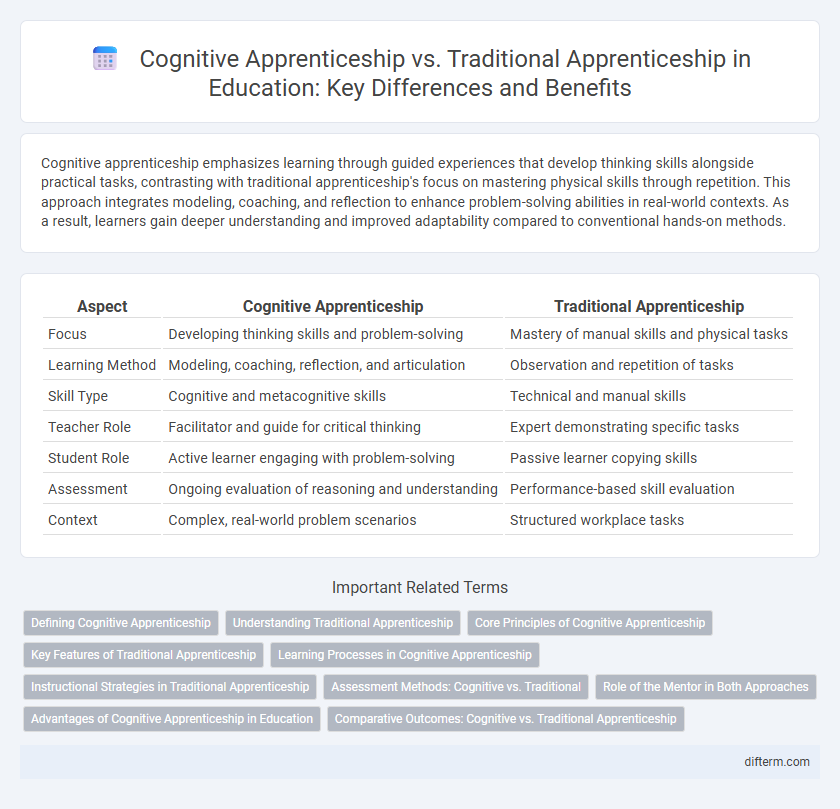Cognitive apprenticeship emphasizes learning through guided experiences that develop thinking skills alongside practical tasks, contrasting with traditional apprenticeship's focus on mastering physical skills through repetition. This approach integrates modeling, coaching, and reflection to enhance problem-solving abilities in real-world contexts. As a result, learners gain deeper understanding and improved adaptability compared to conventional hands-on methods.
Table of Comparison
| Aspect | Cognitive Apprenticeship | Traditional Apprenticeship |
|---|---|---|
| Focus | Developing thinking skills and problem-solving | Mastery of manual skills and physical tasks |
| Learning Method | Modeling, coaching, reflection, and articulation | Observation and repetition of tasks |
| Skill Type | Cognitive and metacognitive skills | Technical and manual skills |
| Teacher Role | Facilitator and guide for critical thinking | Expert demonstrating specific tasks |
| Student Role | Active learner engaging with problem-solving | Passive learner copying skills |
| Assessment | Ongoing evaluation of reasoning and understanding | Performance-based skill evaluation |
| Context | Complex, real-world problem scenarios | Structured workplace tasks |
Defining Cognitive Apprenticeship
Cognitive apprenticeship is an educational model that emphasizes learning through guided experience, where instructors make expert thinking visible by demonstrating processes and providing scaffolding. Unlike traditional apprenticeships focused on physical skills and repetitive practice, cognitive apprenticeship targets mental processes such as problem-solving, critical thinking, and metacognition. This approach integrates modeling, coaching, and reflection to develop learners' internalization of expert strategies in real-world contexts.
Understanding Traditional Apprenticeship
Traditional apprenticeship emphasizes hands-on, experiential learning by working closely with a skilled mentor in a real-world environment, fostering skill acquisition through direct practice and observation. This method relies heavily on repetitive tasks and gradual increase in responsibility, ensuring mastery of specific trades or crafts. Unlike cognitive apprenticeship, it often lacks explicit focus on developing metacognitive skills or articulating the underlying thought processes behind tasks.
Core Principles of Cognitive Apprenticeship
Cognitive apprenticeship emphasizes modeling, coaching, scaffolding, articulation, reflection, and exploration to enhance learning by making expert thinking visible. This approach integrates domain-specific strategies with metacognitive skills, enabling learners to develop problem-solving abilities within authentic contexts. Unlike traditional apprenticeship, which centers on physical task mastery, cognitive apprenticeship focuses on internal cognitive processes and expert reasoning.
Key Features of Traditional Apprenticeship
Traditional apprenticeship emphasizes hands-on skill development through direct mentor-apprentice interaction, often within a specific trade or craft. It relies heavily on observation, repetition, and gradual increase in task complexity to build expertise. Structured timelines and practical work experience are core components, fostering mastery through immersive, real-world practice.
Learning Processes in Cognitive Apprenticeship
Cognitive apprenticeship emphasizes learning processes that involve modeling, coaching, scaffolding, articulation, reflection, and exploration to develop expert thinking and problem-solving skills. Unlike traditional apprenticeship, which primarily focuses on physical tasks and tacit skills transfer, cognitive apprenticeship integrates explicit cognitive strategies and metacognitive development. This approach enhances learners' ability to internalize complex concepts and apply knowledge flexibly across varied contexts.
Instructional Strategies in Traditional Apprenticeship
Instructional strategies in traditional apprenticeship emphasize hands-on learning through observation, imitation, and repetitive practice under the guidance of an expert. The approach relies heavily on tacit knowledge transfer within real-world environments, fostering skill mastery via direct experience and mentorship. Feedback is immediate and informal, ensuring practical problem-solving and adaptive skill refinement.
Assessment Methods: Cognitive vs. Traditional
Cognitive apprenticeship assessment methods emphasize formative evaluation through reflective practice, problem-solving tasks, and ongoing feedback to develop metacognitive skills. In contrast, traditional apprenticeship relies heavily on summative assessments such as final product evaluations and skill demonstrations, focusing on tangible outcomes and procedural proficiency. These differing approaches highlight cognitive apprenticeship's focus on understanding and application, whereas traditional methods prioritize mastery of practical tasks.
Role of the Mentor in Both Approaches
The role of the mentor in cognitive apprenticeship centers on guiding learners through thinking processes, modeling expert strategies, and providing scaffolding to develop problem-solving skills. In traditional apprenticeship, mentors primarily focus on hands-on skill transmission through direct demonstration and supervised practice in specific tasks. Cognitive apprenticeship emphasizes fostering metacognitive awareness and reflection, while traditional apprenticeship concentrates on mastery of physical or procedural competencies.
Advantages of Cognitive Apprenticeship in Education
Cognitive apprenticeship enhances education by making expert thinking visible, allowing students to acquire problem-solving skills through modeling, coaching, and scaffolding within authentic contexts. Unlike traditional apprenticeship, it emphasizes metacognitive strategies, enabling learners to internalize cognitive processes essential for complex tasks and transfer knowledge across domains. This approach fosters deeper understanding and adaptability, preparing students for a dynamic, knowledge-based economy.
Comparative Outcomes: Cognitive vs. Traditional Apprenticeship
Cognitive apprenticeship enhances skill acquisition by integrating explicit teaching of mental processes, resulting in improved problem-solving and critical thinking compared to traditional apprenticeship's emphasis on hands-on practice. Research indicates cognitive apprenticeships facilitate deeper understanding and transfer of knowledge across contexts, while traditional models often yield proficiency limited to specific tasks. Learners in cognitive apprenticeships demonstrate higher adaptability and innovation in real-world applications, reflecting superior comparative outcomes.
cognitive apprenticeship vs traditional apprenticeship Infographic

 difterm.com
difterm.com